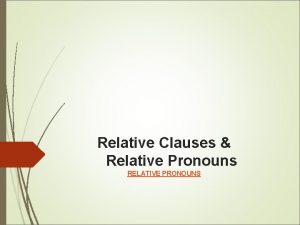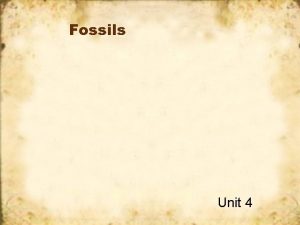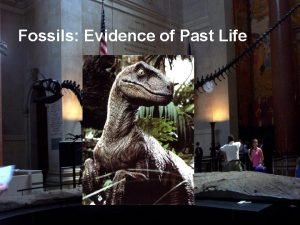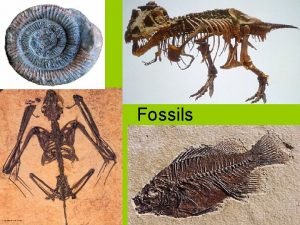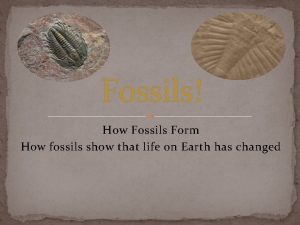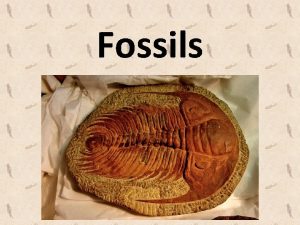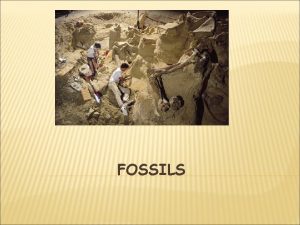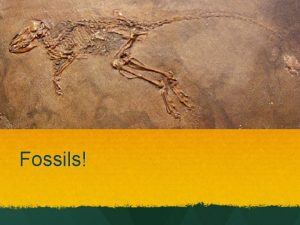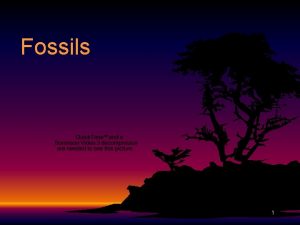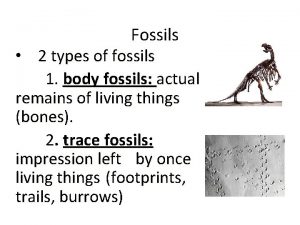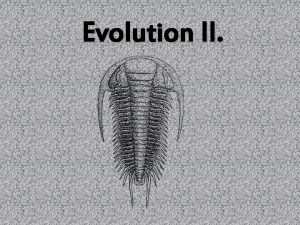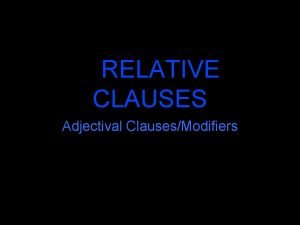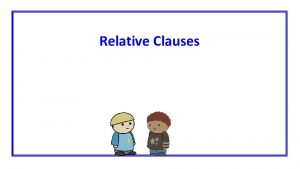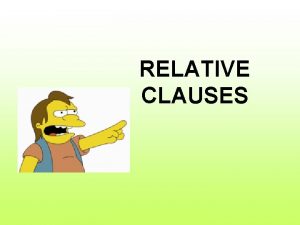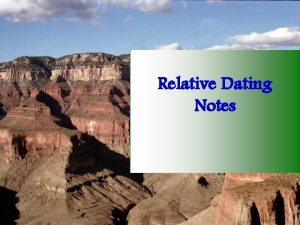The relative ages of fossils 8 th grade





















- Slides: 21

The relative ages of fossils 8 th grade

Standard for this lesson: �Compare fossils found in sedimentary rock to determine their relative age. http: //www. brainpop. com/science/ diversityoflife/fossils/ �

What you will learn… • • How can we tell what lived when? Scientists have developed a number of ways to figure this out. One way is to study clues left behind in layers of rock. These clues are fossils.

Guiding Questions �How can you determine the age of things found in our earth? �What do fossils tell us?

Let’s look at the terms for this unit: � http: //quizlet. com/10800113/flashcards � The ◦ ◦ ◦ key terms are Fossil Absolute age Relative age Sedimentary rock Law of superposition

Fossils • • A fossil is the preserved remains, traces, or imprints of an ancient organism. Fossils help scientists learn about organisms from the past.


Determining the age of rocks • • • Scientists use rocks and fossils to try to date events. Scientists try to determine the absolute age of a rock or fossil. The absolute age is the actual age of a rock or fossil, such as 400 million years old. If you are 14, that is your absolute age.

• • Scientists also try to find out the relative age of rocks and fossils. The relative age is the age of an object or event in comparison to another object or event. For example, the relative age of my house cat will be after the extinction of the dodo bird. Another example, you are younger than I am younger than Mr. Nathan is younger our town. Therefore, your relative age is younger than Dyersburg, Tennessee.

How it works • • • Scientists use the positions of rock layers to determine the relative ages of rocks. Rocks and fossils in the same layer are probably the same age. Rocks and fossils under the layer are probably older, while rocks and fossils above the layer are probably younger.

A fossil can be �A tooth �Bone �Shell �Leaf �Feather �Egg �Footprint

• • • Rocks and fossils Fossils can form when layers of sediment build up over a dead or caught organism. Sediment is carried by water or wind. It settles at the bottom of a body of water and cements and compacts over time. This creates sedimentary rocks. The organism is then preserved in the rock as a fossil. Fossils are most likely to develop where the sediment piles up quickly and doesn’t wash away.

What the layers tell us- • • • When we look at layers, we can see what organisms existed at the same time or close to the same time. We can see the number of organisms from one layer to the next and determine the success of the organism and factors that affect it such as weather and predators. For example, if one layer has many fossils of an organism, but the next layer does not, then we can assume the organism was not as successful during the time of the second layer for some reason. The layers can also help us date the earth and tell the history of its landforms. Ever found a fossil from the sea in Tennessee?

The Law of Superposition • • Evidence of the order in which organisms evolved is found in fossils. This evidence and layering have helped scientists make a geologic time scale. The rocks are layered from youngest at the top to oldest the deeper you go, as long as they have not been disturbed. This is called the Law of Superposition.

The Law of Superposition • • Take, for example, our garbage can. If you were to go through it at the end of the day, the garbage from my first class should be where? What about the last class? Until the janitor dumps the can in the afternoon, this pattern should continue. We could go through the garbage and find evidence about the day and the students who were in this classroom. This tells us the relative age of the fossil. The same thing happens with fossils.

Cross section of the grand canyon:

From all this evidence, we can say-


Who came first? • Paleontologists use relative dating to infer that ages of rocks and thus the fossils in those rocks.

• • • Why fossils? So, what do fossils do for us? They are evidence of the history of the earth. From them, we can learn how organisms have changed over time and how different organisms related to one another. We can study them to determine the ancestors of current organisms and find organisms that are now extinct. We can look at the number of organisms in a layer and examine the success of the organisms.

What else? • • • We can also use fossils to determine which animals came first. For example, which do you think came first, birds or dinosaurs? From their positions in layers of rocks, scientists have determined that dinosaurs evolved before birds.
 Dark ages def
Dark ages def Renaissance art vs medieval art
Renaissance art vs medieval art Grade 7 ages
Grade 7 ages Relative adverbs and pronouns
Relative adverbs and pronouns Relative clauses and relative pronouns stage 15
Relative clauses and relative pronouns stage 15 What are joint relative frequencies
What are joint relative frequencies The person who phoned me last night is my teacher
The person who phoned me last night is my teacher Phản ứng thế ankan
Phản ứng thế ankan Khi nào hổ mẹ dạy hổ con săn mồi
Khi nào hổ mẹ dạy hổ con săn mồi Thiếu nhi thế giới liên hoan
Thiếu nhi thế giới liên hoan Hát lên người ơi alleluia
Hát lên người ơi alleluia điện thế nghỉ
điện thế nghỉ Một số thể thơ truyền thống
Một số thể thơ truyền thống Trời xanh đây là của chúng ta thể thơ
Trời xanh đây là của chúng ta thể thơ Số nguyên tố là gì
Số nguyên tố là gì Tỉ lệ cơ thể trẻ em
Tỉ lệ cơ thể trẻ em Fecboak
Fecboak đặc điểm cơ thể của người tối cổ
đặc điểm cơ thể của người tối cổ Các châu lục và đại dương trên thế giới
Các châu lục và đại dương trên thế giới Thế nào là hệ số cao nhất
Thế nào là hệ số cao nhất Hệ hô hấp
Hệ hô hấp ưu thế lai là gì
ưu thế lai là gì






















